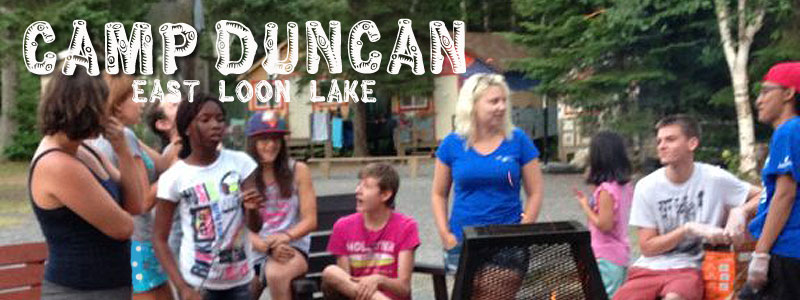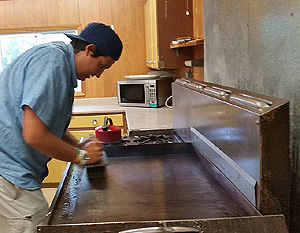 |
|||
|
Camping among United Church members in the Presbytery formerly known as Superior and now entitled Cambrian Presbytery goes back to the late 1920s, as far as can be traced in the old papers relating to the Robert Dewar and Duncan Memorial Camps. Some documents relate to the year 1927, but the first legal documents to be traced in the transaction show that it was 1929 when the first property was officially acquired, a parcel of 20 acres on East Loon Lake, transferred to two ministers Rev.John H. Miller, of Schreiber and the Rev.J.Lyn Clerihue of Fort William, along with local businessman, by Dr. Herman Bryan, a physician. This property subsequently became known as the Robert Dewar Memorial Camp. According to legal documents found in the archives of Camp Duncan, the first parcel was purchased for $201, while the second parcel was acquired Feb. 24, 1931 at a cost of $499. Five buildings were built on the property next to Anderson Creek that ran alongside it. These buildings housed a dining room and kitchen, located near the creek, while a larger building, built on the hill, a bit back from the lake, was used as a dormitory for many of the campers. Between the two bigger buildings were three small ones used as sleeping quarters for the cook, camp director and some of the campers. The site was located across the lake, accessible only by boat from the main dock at West Loon, since no road existed into the property at that time. Today a road from East Loon comes within easy walking distance of the Dewar Memorial Camp property. Campers and supplies had to be ferried across the lake, which at times could be a rather precarious trip, according to Earl Buckley, one of this report's authors. A chapel was built on a rock near the lake and many a good sing song wafted it way across the placid waters as part of the church camping program. The Robert Dewar Memorial Camp operated as a United Church camp until in 1944 Mrs. G.R. Duncan, wife of a local realtor and insurance businessman sold a beautiful camp site at East Loon Lake for the sum of $1,000 as a memorial to her husband. In that year Superior Presbytery set up a body of people to be known as Thunder Bay United Church Camps Incorporated, for the purpose of planning, building and operating a camp suitable for taking care of summer camping for the youth and others of the United Churches wishing to use this facility. The first business was to obtain a charter and this having been done, plans were drawn up and building commenced soon after a successful campaign to raise $7,000 to build an assembly and dining hall with kitchen attached, and later, 10 cottages to accommodate up to 100 youth with leaders. It was hoped all congregations of the United Church Camp at the Lakehead would give wholehearted support to the project. Until the early 1950s, campers were housed in tents. Between 1952 and 1956 10 cabins were built and a number of outhouses. Later a tool shed was built and in 1956 a manager's hut was constructed. It is of interest to note that in 1947, the first year of the camp's operation, there was a boys' camp, CGIT, Girl Guide and Family Group Camp. Altogether, there were a total of 1600 camp days. The camp is still serving our church groups, but they are not at this time (1991) utilizing the facility to the extent it was back in 1947, and outside groups have been given use of the camp to augment our income. In 1963, a program of camp renovations and extension was undertaken. Presbytery undertook to raise $5,000 and other donations were solicited. The kitchen area was enlarged with a basement being put beneath the enlarged portion wherein washrooms for boys and girls were installed. New linoleum was laid on the main lodge floor. The kitchen and main lodge were rewired and the lighting modernized. The UCWs of Wesley, Trinity and Vickers Heights provided new stacking chairs and tables. A work party organized by Earl Buckley's committee had new cupboards made for the kitchen during the winter months and these were installed in the enlarged kitchen. The property committee under Cecil Seaman, had a large concrete septic tank built and the necessary field tile laid by a gang of volunteers from the churches. In 1969 Wesley United Church men tore down and rebuilt the crafts building moving it a few feet back as ordered by Ontario Hydro whose wires were above the old building and the managers building was also moved from beneath the wires. The craft building had lost its roof due to snow overload and had to be rebuilt. In 1974 further improvements were made. Arrangements were made to provide free use of the camp to inmates of the correctional centre, in exchange for work and this practice has been carried out for a number of years now. Through the excellent workmanship of these people, all 10 cabins have now been refurbished, old metal bunks being replaced by permanent wooden ones affixed to the walls. Fresh paint has made the cabin interiors much brighter. The old hospital type mattresses are being gotten rid of in favor of foam ones, which can more readily be cleaned. Mattress covers are being added to help provide a much cleaner environment. A new stairway was completed in 1989/90, leading down to the baseball diamond and beach area, the new being constructed of treated lumber. All cabins have been re shingled over the past several years and washrooms have been made much cleaner looking by the installation of a drop ceiling and tiles, with inset fluorescent lighting fixtures and new sink and vanity in the boys' washroom. A sufficient number of baseboard heaters were donated in 1990 by Len Poling, and a $6,000 low interest loan from Cambrian Presbytery in 1992, allowed us to replace the main panel controls and allow for the installation of the underground wiring required to hook up the heaters in the cabins, thereby making them much more comfortable on cool nights, and perhaps even allowing us to extend the camping season by an earlier start in spring and a later closing in fall. The Correctional Centre inmates also assisted us by building new picnic tables and bench couches for the main lodge and in 1992 rebuilt our shower stalls in the main shower building and added more picnic tables and fireside benches, in addition to finishing off all but No. 2 cabin. It should also be pointed out that the main lodge was made wheelchair accessible by installation of a ramp. From a recreational viewpoint Camp Duncan offers a baseball diamond, volleyball court, swimming, canoeing (there are 11 aluminum canoes), cross-country skiing in winter and nature trails and a vast area of God's country to be enjoyed. A total of nine acres is encompassed by the camp. Evenings can be spent around a campfire or in inclement weather, one can hold a campfire singsong around the lodge's fireplace, which augments the oil fired furnace and baseboard heading of the main lodge. New coffee makers, a 10-cup and 40-cup, as well as a Black Angus rotisary countertop oven were donated by former Chairman Gerry Poling and his wife Marjorie, as well as a large microwave oven. The camp has been made winter habitable and has been used all winter in some instances, such as for Katimavik, who used the heated cabins, the heaters and furnace in the main lodge and heaters in the bathrooms and the well which allowed them to have sewer and water all winter. |
|||
|
|
|||



 Our kitchen facilities offer three refrigerators, a freezer, a large propane fired cook stove with double ovens, two electric ranges and ovens, a triple stainless steel sink, massive counter space and most appliances such as blender, toasters, coffee maker, milk machines etc. In late June it was learned that a newer propane stove/ grill was available through Shuniah Council's McTavish Rec Centre. A bid of $600 for the stove, which is valued at over $5,000, was accepted and it appears we will soon have a new stove in our kitchen and a revamping of that area.
Our kitchen facilities offer three refrigerators, a freezer, a large propane fired cook stove with double ovens, two electric ranges and ovens, a triple stainless steel sink, massive counter space and most appliances such as blender, toasters, coffee maker, milk machines etc. In late June it was learned that a newer propane stove/ grill was available through Shuniah Council's McTavish Rec Centre. A bid of $600 for the stove, which is valued at over $5,000, was accepted and it appears we will soon have a new stove in our kitchen and a revamping of that area.